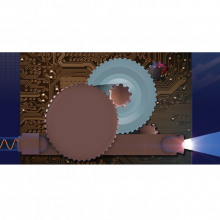Only a few decades ago, finding a particular channel on the radio or television meant dialing a knob by hand, making small tweaks and adjustments to hone in on the right signal. Of course, we now take such fine tuning for granted, simply pressing a button to achieve the same effect. This convenience is enabled by radio frequency synthesis, the generation of accurate signal frequencies from a single reference oscillator. The need for better radar in World War II drove the development of radio frequency control, and its miniaturization in subsequent decades revolutionized a host of military and consumer applications. Today, precise, stable frequency synthesizers are found everywhere, from GPS systems to smartphones and TV remote controls.
While radio frequency control has long since graduated, optical frequency control on the other hand still exists in the bygone “tuner knob” era. The absolute frequency (or color) of light from a laser is difficult to set with precision, and laser frequencies tend to drift. The development of the “optical frequency comb” garnered a Nobel Prize in 2005, and enabled the demonstration of the first optical frequency synthesizer. These systems, analogous to their radio-frequency counterparts, allow light to be generated on demand at exact wavelengths with errors of less than 10-15 or one-part-per-quadrillion....
....
Associated images posted on www.darpa.mil and video posted at www.youtube.com/darpatv may be reused according to the terms of the DARPA User Agreement, available here: http://go.usa.gov/cuTXR.
